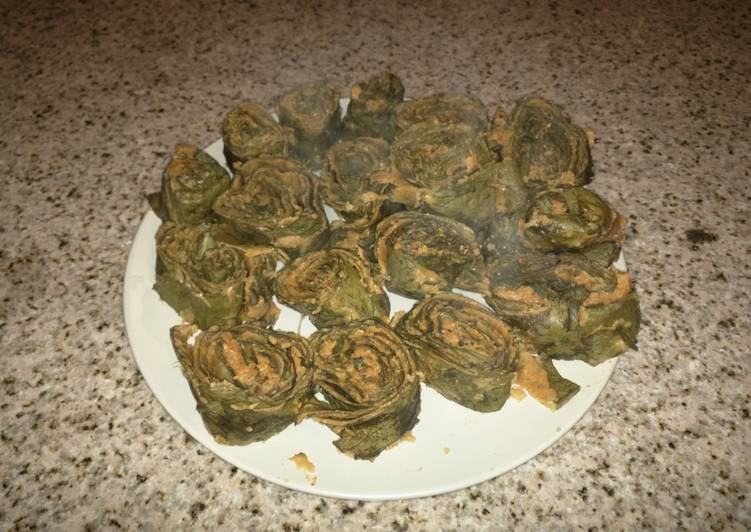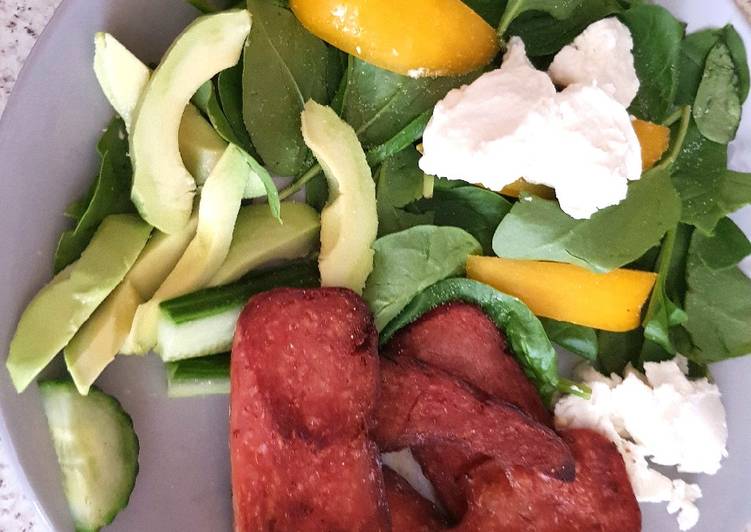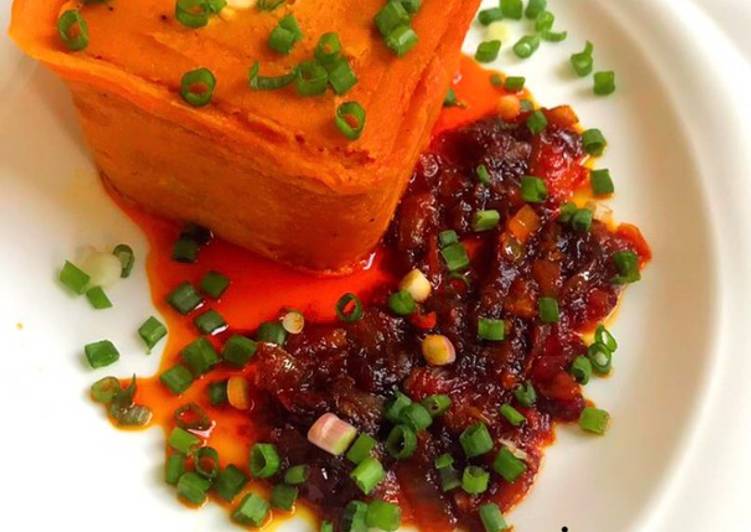
Hey everyone, I hope you’re having an amazing day today. Today, I’m gonna show you how to make a distinctive dish, pathrode (patra). One of my favorites food recipes. For mine, I will make it a little bit unique. This will be really delicious.
Pathrode (Patra) is one of the most well liked of recent trending meals in the world. It’s enjoyed by millions daily. It’s simple, it is quick, it tastes delicious. They are fine and they look fantastic. Pathrode (Patra) is something which I’ve loved my entire life.
Alu vadi or pathrode recipe With step by step photos - alu vadi also known as patra is stuffed rolled colocasia leaves snack that is popular in both Maharashtrian and Gujarati cuisine. Pathrode or patrode is a very tasty snacks or breakfast recipe prepared using rice and colocasia leaves. Pathrode or patrode is also familiar by name patra vadi or patra vada.
To get started with this recipe, we must first prepare a few components. You can cook pathrode (patra) using 12 ingredients and 17 steps. Here is how you can achieve that.
The ingredients needed to make Pathrode (Patra):
- Prepare 20 Colocasia leaves (Patra leaves)
- Get 3 cup Rice, soaked for about 6 hours or overnight
- Take 15 piece dried red chillies
- Get 2 tbsp coriander seeds (sabut dhaniya)
- Make ready 2 tsp cumin seeds (sabut jeera)
- Take 1 cup shredded coconut
- Make ready 1 piece tamarind, lemon sized lump
- Prepare 1/2 tsp Fenugreek (methi) seeds
- Take 1 salt, to taste
- Get 1 water, as needed
- Take 1 stick butter
- Make ready 2 tbsp oil (optional)
Today's post is one such masterpiece dish of Mangalorean cuisine (coastal Karnataka) "Pathrode". Its also famous in both Maharashtrian and Gujarati cuisine as "alu vadi" and "patra" respectively. Arvi Patra Patra (patrveliya) also called as alu vadi or pathrode in Marathi. Unlike the name reflects alu or aloo (potato in hindi) it has nothing to do with potatoes.
Steps to make Pathrode (Patra):
- Prep the colocasia leaves. Wash them well, and pat dry.
- Flip the leaves over, and strip off the thick spines of the leaves. The sap from these stems can cause throat itches and irritation. They are also fibrous, and quite unpleasant in the mouth. It is alright of the leaves are slightly damaged.
- Blend all the other ingredients (rice, coconut, red chillies, coriander, cumin, tamarind, salt, fenugreek, little bit of water to help blend) into an almost fine paste. The paste should have a spreadable consistency, and a grainy texture.
- IMPORTANT: Taste the paste at this time - there's no fixing the paste later. The leaves themselves have a very mild flavor, so the flavors on the paste ought to be a bit strong. You should be able to taste the zing from the tamarind, the heat from the chillies, and the salt a bit stronger than you normally would like.
- Now for the messy and fun bit. Ensure that you have a clean, dry workspace. Lay the biggest colocasia leaf you can find, face down on the surface. Smear a dollop of the prepared paste on the entire leaf.
- Lay another (smaller) leaf on top of the first leaf, again, face down. Smear a dollop of the spiced paste on this leaf too.
- Repeat with about 5 or 6 leaves.
- Once that's done, begin rolling all the leaves into a tight cylinder. Do this by folding the wider sides of the leaves inwards and then rolling from the bottom of the leaves toward the pointy sides. Make sure that the roll is tight, and not much of the spice paste oozes out. A little of the paste should be visible from the outside, it gives the final dish a great look and great taste.
- Keep the roll aside, and prepare similar rolls with the rest of the leaves. You should be able to prepare about 4-5 rolls.
- Prepare a water bath for steaming the rolls. Note that you need to steam the rolls, and not boil them.
- Once the water starts boiling, place the rolls into the hot steam, and close with a tight lid.
- Let the rolls cook in the steam for about 30 minutes.
- Once you remove from the steam, let it cool down a bit, and use a sharp knife to cut smaller cylinders out of these rolls.
- OPTIONAL: If you have some of the spice paste left over, smear a light layer on top of the pieces of pathrode, and lay on a hot griddle. Drizzle oil or ghee on top to shallow fry the pieces. Fry until there are brown spots all over. This happens from the sugars in the coconut and rice caramelizing. This is optional, and the pieces taste great as is.
- Serve with a dollop of butter on top of each piece, and enjoy the dish hot!
- NOTE: If you have an itchy throat while you eat this dish, drink a glass of buttermilk or have some yogurt. If the dish is cooked right, you should not have an itchy throat. The tamarind should take care of the itchiness from the leaves.
- OPTIONAL: If the ingredients disintegrate when you steam them, no problem. Roughly shred everything. In a pan, take some oil. Once the oil is hot, add some mustard seeds, black gram (urad dal split), red chilli flakes, curry leaves. Once the mustard seeds splutter, and the shreds of pathrode, and add some sugar. Toss for a minute and serve hot!
It is made by colocassia leaves also called. Also known as Patra in Gujarati or Pathrado in konkani, the colocasia leaves sometimes could be hard to find here in the US Cuisine: Indian. Ask any Gujarati about the snacks popular in the state, and they'll mention patra. Pathrode is an unique snack from the regions of Udupi-Mangalore. Hi everyone Today we are going to be making gujrati patra.its also known patarvelia,patrode and alu vadi.
So that’s going to wrap it up with this special food pathrode (patra) recipe. Thanks so much for reading. I’m confident that you will make this at home. There’s gonna be interesting food in home recipes coming up. Don’t forget to save this page in your browser, and share it to your loved ones, colleague and friends. Thanks again for reading. Go on get cooking!

